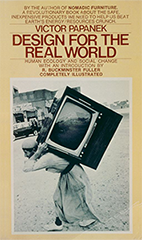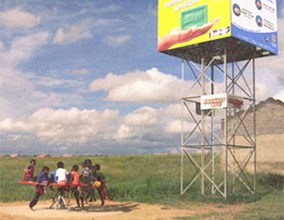
A philosophy of design
Design tickles my neurons.
Determining a style or philosophy of my work is tough. I'm not sure one should have a recognizable style - design solutions should be appropriate for the specific problem at hand. If a style can be spotted, then there may be too much of the designer's preference's creeping in, rather than preferences for appropriate elements. My philosophy of design is that it is a way of thinking, a way of making things better, and a way of solving problems in a fresh way. It is efficient solutions that make things better. Design is the tickling feeling that happens in my brain.
I realized I had a design sense and was a designer when I was about 12 years old.
Around age 28, I wrote in my journal, Design Goal: Make people aware of the need for design and to raise
their level of design consciousness. I can do that by being an influential designer in 3 areas:
1. Design projects. I will use "Bob Watson designs." as a marketing tool to represent logical, intelligent quality design. Will have a design laboratory for R&D - a work space.
2. Teaching. To share knowledge, instill ideas, inspire, help, & create an appreciation for good design.
3. Published works. To educate those people not in a classroom situation.
A few characteristics of my work and thinking:
Looking back at my body of work, I can spot some commonalities that show up, not consistently, but enough to begin a discussion of a Watson style.
• Unique use of materials - spotting possibilities for new uses for everyday items, materials, and products.
• An industrial, contemporary, modern, aluminum, sleek appearance.
• Using angles and overlapping grids, especially in architecture and interior design. Each is appropriately justified within its problem context (street grid angles in NYC, thinking outside of the box in the Design Office, etc.) A grid provides a sense of structure and order but its more dynamic when offset by the unexpected, the twist that makes life interesting.
• Alignments - exploiting the way elements relate to each other with a sense of order, clarity, and efficient organization.
• Minimalism - the brain is busy enough, physical environments, products, graphics can help by being clear, simple, and uncluttered.
• Logic, reason, intelligence - not much of my work is random or without reason.
• Flow and efficiency - I seek to improve and enhance the chaotic world we live in.
A few major influences
• The genius typographer and designer Herb Lubalin.
• The architect, urban planner, and designer Frank Lloyd Wright.
• The Arts & Crafts movement.
• Travel to other countries, cultures, and ideologies.
• Immersion in the inspiration from New York City.
• Early foundation in set design.
• Growing up in Texas in the 1950s.
• Great active high school, college, and work experiences.
To impact my work, I strive to:
• Play the role of the user and see possible solutions through virgin eyes - seeing in a fresh way. To use vista vision to objectively spot strengths and weaknesses.
• See the bigger picture the problem is a part of - see all sides and various ramifications.
• Integrate type and image (as inspired by Herb Lubalin).
• Make things better (and not just in design).
• Speak up when I feel something can be improved.
• Clearly communicate.
• Find rationale for design decisions.
• Solve mind games, puzzles, and word games - to keep my mind sharp.
• Pay attention to detail.
• Conduct research - to become an authority on the problem -get to know the audience and seek what the client really wants/needs, not just what they say they want.
• Think creatively, in new ways, to make connections that weren't there before.
• Improve the professionalism of the industry.
• Courageously take risks.
• Possess integrity and enthusiasm.
Design tickles my neurons - it makes me feel alive, joyous, energized, and enthusiastic about possibilities. I truly believe design is fun.
To read more about Jim Watson's thoughts on design, also read the Design Keys, Design Guidelines, and The Design Process.


The professional design community and design schools should direct their practices toward socially responsible, sustainable, humanitarian design. We can better prepare solutions that are simple, cheap, easy to produce and distribute, and meet a direct human need. In 1971, Victor Papanek published his ground-breaking book, Design for the Real World: Human Ecology and Social Change in which he indicted the Western consumerist mentality as well as the design community: "the genuine needs of man have often been neglected by the designer."
The Cooper-Hewitt National Design Museum had a show and published a catalog, Design for the Other 90%. This issue has fascinated me since I was in college in the late 60s - most design, billions of dollars worth, is produced for the top 10% of the planet, for the more well-off and industrialized nations. Some examples: though accounting for only 5 percent of the world's population, Americans consume 26 percent of the world's energy (American Almanac) and produce 25 percent of the carbon dioxide pollution from fossil-fuel burning. Industrialized nations, with 20 percent of the world's population, consume 87 percent of the world's paper (Klaus Toepfer).
Nearly half of the world's population lives on less than $2 a day. There is a huge undeserved population that needs great design - innovative solutions to problems of food, clean water, education, and skills. Designers are trained to make things better, to address social ills as well as commercialism. Most designers spend their entire career designing graphics for a highly commercialized and competitive environment. Imagine if designers spent 10% of their time, talent, and resources to help people grow crops more efficiently, to get and keep water that is pure, to harness energy efficiently and cheaply, or to communicate to each other over long distances. Designers, then, truly could and would make a difference.



Above: Pump operated by foot walking action. Kid's merry-go-round that pumps water up to a storage tank.
Below: Gourd-on-head way to transport water, replaced by larger capacity and safer rolling jugs.


www.jamesrobertwatson.com/designphilosophy.html